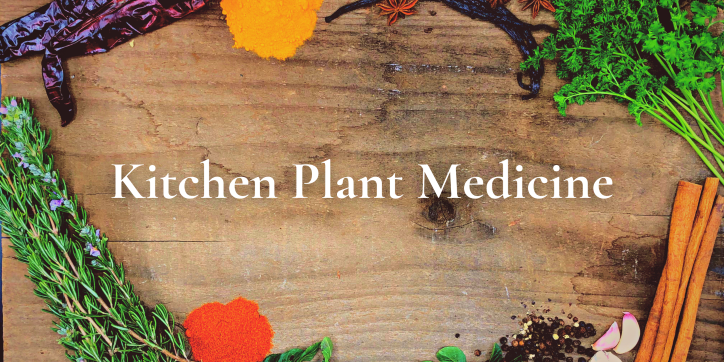
We offer Kitchen Plant Medicine
as part of Herbs & Nutrition 101
&
The Foundational Herbalism Program.
Consisting of 23 information-packed videos.
You will also receive a downloadable study guide.
Cinnamon snow atop your french toast. Thyme dancing in the marinara sauce. Lemongrass and ginger spice fill the air of your favorite Thai restaurant. Grandma's enchiladas with their trademark kick from the spicy chilies grown in her garden. It is the herbs that spark delightful aromatic memories wrapped around a favorite meal. Herbs bring incredible flavors and scents to the dining experience,
but are not the only reasons why you should use herbs and spices in cooking.
Cooking with spices is often the first introduction to using herbs many of us have and by exploring these common culinary spices — spices you likely already have in your kitchen cabinets! — by botanical name, plant family, and parts used, we deepen our gratitude to the food that sustains us.
Did you know many of the leafy spices we so regularly use in soups, stews, and sauces are all from the Lamiaceae family?
Or better known as the mint family? Or those seeds we crush into rubs and blends primarily come from the Apiaceae family? A.K.A. the carrot family? These explorations will take us to places around the world as we dive into the history of spice's use around the globe.
Through spending many years learning to cook in professional kitchens, Shana fell in love with her studies in plant medicine, physiology, botany and ecology and realized Kitchen Plant Medicine was the beautiful blending of her passions. In a class near and dear to her heart, Shana mixes her love of delicious food with inspiring people to connect to where their food comes from topped with empowering people to realize they have a medicinal apothecary in their tea and spices cabinet.
In this online course you will learn:
- Medicinal uses of common culinary spices and herbs that you likely have in your kitchen already
- About the commonly available solvents hidden in your cabinets
- Botanical names and families of culinary herbs
- The history and traditional uses of these spices covering the spice trade and global movement of spices.
- How to use culinary spices and herbs in your meal-making, plus many new recipes to try!
You will have access to:
- All 23 online video classes to watch at your own pace
- 12 hours of content!
- Unlimited viewing
- List of delicious and easy-to-follow recipes
Take this course if you:
- Love food
- Enjoy cooking and want to share healthier and medicinally rich meals with your family and community
- Are looking for sensible and easy-to-follow healthy recipes to add to your weekly meal rotation
- Want to empower all those who enter your kitchen to access healthy, flavorful, and medicinally nutritious food.
Cost $ 199.00
Syllabus
12 Hours of content!
Permanent access
Class #1 Introduction to the food & medicine in your kitchen
Class #2 How can food be medicine?
Class #3 Salt
Class #4 Pepper
Class # 5 Oil as a solvent
Class # 6 Water as a solvent
Class # 7 Vinegar as a solvent
Class # 8 Alcohol as a solvent
Class # 9 Honey & Sugar
Class # 10 Chilis
Class # 11 Alliaceae family introduction
Class # 12 Onions & Shallots
Class # 13 Garlic, Leeks & Chives
Class # 14 Zingiberaceae family introduction
Class # 15 Ginger & Turmeric
Class # 16 Lamiaceae Family Introduction
Class # 17 Basil
Class # 18 Thyme & Oregano
Class # 19 Rosemary
Class # 20 Sage
Class # 21 Mint
Class # 22 Catnip
Class # 23 Lavender
© Copyrights by Sage Country Herbs. All Rights Reserved.
